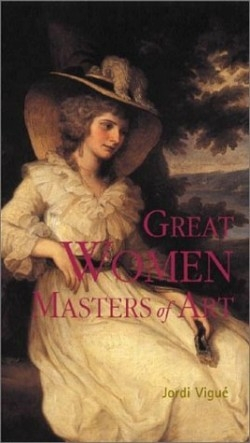Great Women Masters of Art
“Painting is in the mind. Art is not a matter of gender, but of the intellect,” said Leonardo daVinci, trying to dispel the myths that are believed even today: that paintings executed by women radiate a feminine aura, and are inferior to those by male artists. The author provides insight to the true world of women artists through this new book.
Vigué begins with antiquity, examining paintings by Lea of Cicico, who commanded prices beyond those of the most famous portraitists of her time, and continues through the Middle Ages with Gisela, sister of Charlemagne, who ran a monastery and illuminated hundreds of manuscripts. The book then moves through the Renaissance, Baroque, and Enlightenment periods, and concludes with the nineteenth and twentieth centuries, mentioning the Russian Blue Rider group and American Helen Frankenthaler, among others.
Eighty-two women artists from the United States and Eastern, Central, and Western Europe are included, with sidebars of biographical timelines and histories, full-color photographs, and content covering each painter’s inspiration, evolution, and technique. The book’s dimensions make it easy to hold in the hand, yet the good-sized photographs of the art allow the viewer to study details. Names of artists are printed in top corners of pages, alongside a detail thumbprint of the works, providing both visuals and text for navigation.
An accomplished publisher of monographs, magazine articles, and encyclopedias, Vigué has also published this book in Barcelona, Spain. Having studied art history at the University of Sorbonne, Paris, he takes a clear, objective approach to his subject.
Although the artists Vigué discusses were generally born into artistic milieus or families of nobility (which allowed them access to music, dance, and painting), many limitations were placed on them. They were prohibited from practicing certain professions-like painting. They were permitted to paint only genres assigned from the academies, which often forbade women to attend. Their activities were controlled, and the value of their works was always being questioned. Despite these limitations, many women artists excelled in their mediums and continued to paint.
Born in 1593 to a painter in Rome, Artemisia Gentileschi took up painting because her father allowed her to work in his studio, and asked his friend to teach the girl perspective. After repeated sexual abuse, Artemisia took the perpetrator to court. The trial brought out accusations and humiliation, which profoundly marked her life and her art. Her painting of a biblical scene where the female heroines confront a powerful and domineering man, Judith Slaying Holofernes, shows a superb use of chiaroscuro, which adds to the painting’s drama.
Another painting shows a sitter in a relaxed position, wearing a loose white dress, casually smoking after a meal. Not a typical scene from the Victorian age, when Finnish artist Elin Danielson executed At the Breakfast Table. The white lace of the dress, the glare of the blue Danube teacup, and the outline of the milk glass egg holder are illuminated by the path of light entering the room. Danielson emulated certain Impressionistic Masters through her application of light, color, and brushstroke. She struggled to defend her freedom as a single working artist, and today her work is valued not only for its aestheticism, but for its defense of women’s rights.
Suzanne Valadon, another modern artist, had to resign from her job as a trapeze artist in a Parisian circus after a fall that left her temporarily paralyzed. To earn a living, she posed as a model for artists like Degas, Renoir, and Toulouse Lautrec, and she soon took up painting and drawing on her own. In The Fishermen, Valadon shows simplification of forms and vivid use of color and line, presenting a vibrant vitality consistent with the male artists of her day.
Unfortunately, some of the book’s photographs are of poor resolution, making it difficult to fully appreciate the quality and nature of the paintings. Also, the book lacks descriptions of the women’s circumstances and societal roles, which could have given the reader a better sense of the constraints women artists faced. Vigué and his collaborators faced difficulties in research due to little information being available. For example, the artist Sofonisba Anguissola was paid with luxurious gifts rather than currency, which makes it hard for historians to track payment records and documentation.
These criticisms are insignificant, considering the important reference point Vigué has provided in studying this too-often overlooked portion.
Disclosure: This article is not an endorsement, but a review. The publisher of this book provided free copies of the book to have their book reviewed by a professional reviewer. No fee was paid by the publisher for this review. Foreword Reviews only recommends books that we love. Foreword Magazine, Inc. is disclosing this in accordance with the Federal Trade Commission’s 16 CFR, Part 255.

